| Pisco Formation | |
|---|---|
| Stratigraphic range: Mid Miocene-Early Pleistocene (Colloncuran-Uquian) ~ | |
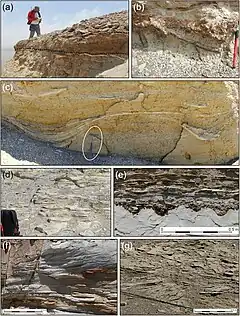 Lithology and sediments of the Pisco Formation across its allomembers | |
| Type | Geological formation |
| Unit of | Pisco Basin |
| Overlies | Chilcatay & Caballas Formations |
| Thickness | 640 m (2,100 ft) |
| Lithology | |
| Primary | Tuffaceous sandstone, diatomaceous siltstone |
| Other | Conglomerate, dolomite |
| Location | |
| Coordinates | 15°42′S 74°30′W / 15.7°S 74.5°W |
| Approximate paleocoordinates | 15°48′S 73°48′W / 15.8°S 73.8°W |
| Region | Arequipa & Ica Regions |
| Country | |
| Extent | From Pisco to Yauca |
| Type section | |
| Named for | Pisco |
 Outcrops of the formation in Peru | |
The Pisco Formation is a geologic formation located in Peru, on the southern coastal desert of Ica and Arequipa. The approximately 640 metres (2,100 ft) thick formation was deposited in the Pisco Basin, spanning an age from the Middle Miocene up to the Early Pleistocene, roughly from 15 to 2 Ma. The tuffaceous sandstones, diatomaceous siltstones, conglomerates and dolomites were deposited in a lagoonal to near-shore environment, in bays similar to other Pacific South American formations as the Bahía Inglesa and Coquimbo Formations of Chile.
Several specialists consider the Pisco Formation one of the most important Lagerstätten,[1][2] based on the large amount of exceptionally preserved marine fossils, including sharks (most notably megalodon), penguins, whales, dolphins, birds, marine crocodiles and aquatic giant sloths.
Famous fossils found in these layers include the giant raptorial sperm whale Livyatan,[3] the aquatic sloth Thalassocnus,[4] the sperm whale Acrophyseter, and the walrus-like dolphin Odobenocetops.[5]
Description
The Pisco Formation of the Pisco Basin consists of tuffaceous sandstones, diatomaceous yellow to gray siltstones and a basal conglomerate.[6] The formation is deposited from Pisco in the north to Yauca in the south. The northern portion is known as the Ocucaje Area and the southern part as the Sacaco Area.[7] The total thickness of the formation is estimated at 640 metres (2,100 ft).[8] The formation unconformably overlies the Chilcatay and Caballas Formations.
Fauna
The Pisco Formation has provided a rich resource of marine fauna, including marine mammals like cetaceans and seals, large fishes, reptiles, and penguins.[9] It is also one of the richest sites in the world for fossil cetaceans, with close to 500 examples being found in the formation.[10]
The oldest fossils of the aquatic sloth Thalassocnus (T. antiquus) come from the Aguada de Lomas horizon of the Pisco Formation and were dated at roughly 7 Ma. The youngest specimen (T. carolomartini) was found in the Sacaco horizon and dated to approximately 3 Ma.[11] Thalassocnus was preyed upon by the probable apex predators of the environment, Livyatan and megalodon.[12][13] The youngest strata belonging to the formation have been dated at 2 Ma, corresponding to the Early Pleistocene (Uquian). Fossils of the Humboldt penguin were found in these deposits at the Yauca locality.[14]
Vertebrates
Mammal
Pinniped
| Pinniped | ||||
|---|---|---|---|---|
| Taxa | Species | Description | Images | Notes |
| Acrophoca | A. longirostirus | A large pinniped thought to be the ancestor of the leopard seal |  |
|
| Australophoca | A. changorum | TBA | ||
| Hadrokirus | H. martini | A species of true seal | ||
| Hydrarctos | H. lomasiensis | TBA | ||
| Piscophoca | P. pacifica | A seal | 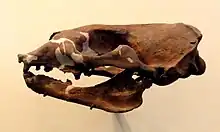 |
|
Cetacean
| Cetacean | ||||
|---|---|---|---|---|
| Taxa | Species | Description | Images | Notes |
| Acrophyseter | A. deinodon | A small raptorial physeteroid | 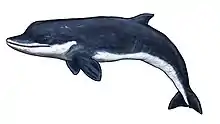 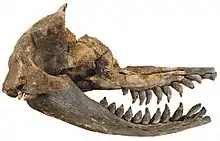 |
|
| A. robustus | ||||
| Atocetus | A. iquensis | A small toothed whale | 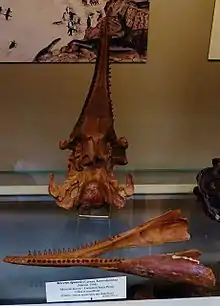 |
|
| Australithax | A. intermedia | A long-snouted porpoise | ||
| Balaenoptera | B. siberi | A baleen cetacean |  |
|
| Belonodelphis | B. peruanus | An long delphinid | ||
| Brachydelphis | B. jahuayensis | An early delphinid | 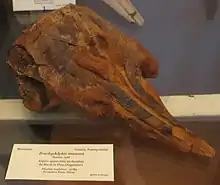 |
|
| B. mazeasi | ||||
| Brujadelphis | B. ankylorostris | A river delphinid | ||
| Hemisyntrachelus | H. oligodon | An early form of orca | 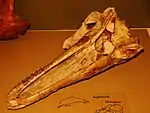 |
|
| Incakujira | I. anillodefuego | A small baleen cetacean | 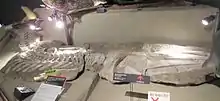 |
|
| Kogia | K. danomurai | A basal member of the Kogia genus. Small physeteroid | ||
| Koristocetus | K. pescei | A small sperm whale | 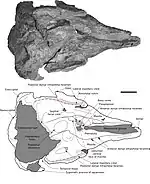 |
|
| Livyatan | L. melvillei | An 18-meter long raptorial physeteroid with 36 centimetres (1.18 ft) teeth | 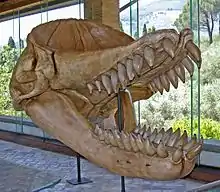 |
|
| Lomacetus | L. ginsburgi | A cetacean | ||
| Miocaperea | M. pulchra | A cetothere whale | ||
| Ninoziphius | N. platyrostris | A giant beaked whale | ||
| Odobenocetops | O. leptodon | A cetacean with dual tusks | 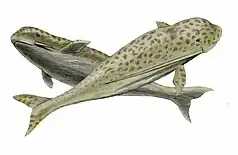 |
|
| O. peruvianus | ||||
| Piscobalaena | P. nana | A small baleen whale | 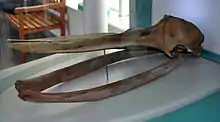 |
|
| Piscocetus | P. sacaco | An extinct cetacean | ||
| Piscolithax | P. aenigmaticus | A porpoise | ||
| Pliopontos | P. littoralis | An early delphinid | ||
| Scaphokogia | S. cochlearis | An extinct pygmy sperm whale | ||
Xenarthra
| Xenarthra | ||||
|---|---|---|---|---|
| Taxa | Species | Description | Images | Notes |
| Thalassocnus | T. antiquus | a semi-aquatic marine sloth | 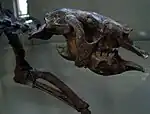 |
|
| T. carolomartini | ||||
| T. littoralis | ||||
| T. natans | ||||
Fish
Chondrichthyes
| Cartilaginous fishes | ||||
|---|---|---|---|---|
| Taxa | Species | Description | Images | Notes |
| Carcharias | C. taurus | The sand tiger shark | 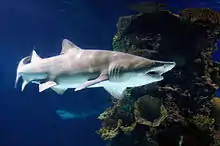 |
|
| Carcharhinus | C. sp. indent | A requiem shark | ||
| Carcharodon | C. carcharias | The great white shark |  |
|
| C. hubbelli | ||||
| Cosmopolitodus | C. hastalis | The broad-toothed mako | 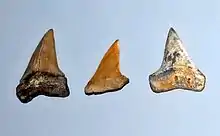 |
|
| Hexanchus | H. gigas | A cow shark |  |
|
| Isurus | I. oxyrhincus | The shortfin mako | 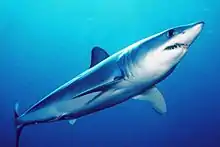 |
|
| Myliobatis | M. sp | A species of eagle ray | ||
| Otodus | O. chubutensis | |||
| O. megalodon | The largest of the megatoothed sharks (and of all fishes) | 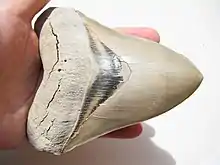 | ||
Actinopterygii
| Bony fishes | ||||
|---|---|---|---|---|
| Taxa | Species | Description | Images | Notes |
| Alosinae | A. indent | A type of herring | ||
| Centropomidae | C. aff. Psamoperca | A snook fish | ||
| Triglidae | T. indent | A type of sea robin | ||
| Xiphiidae | X. ident | A sword fish | ||
| Xiphiorhynchus | X. sp | A ray-finned fish | ||
| Sardinops | S. sp. | A sardine | ||
Birds
| Birds | ||||
|---|---|---|---|---|
| Taxa | Species | Description | Images | Notes |
| Spheniscus | S. humbodti | Humboldt penguin | 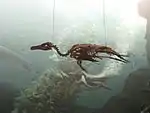 | [14] |
| S. megarhampus | Banded penguin |
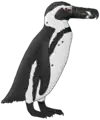 | [14] | |
| S. muizoni | The oldest banded penguin | 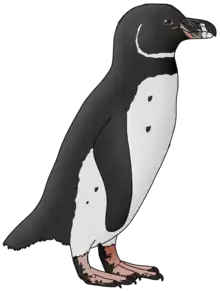 | [36][37] | |
| S. urbinai | A larger banded penguin than S. muizoni |
 |
[14] | |
| Rhamphastosula | R. aguierrei | 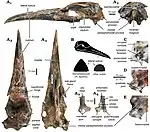 |
||
| R. ramirezi | ||||
| Sula | S. brandi | |||
| S. magna | ||||
| S. sulita | ||||
| Morus | M. peruvianus | |||
| Perugyps | P. diazi | |||
| Fulmarus | Fulmarus sp. | |||
| Pelagornis | Pelagornis sp. |  |
||
| Pelecanus | Pelecanus sp. | |||
| Phalacrocorax | P. aff. bougainvillii | |||
| cf. Phalacrocorax sp. | ||||
Reptiles
| Reptiles | ||||
|---|---|---|---|---|
| Taxa | Species | Description | Images | Notes |
| Sacacosuchus | S. cordovai | A gavialid crocodylian | ||
| Piscogavialis | P. jugaliperforatus | A gryposuchine gavialid crocodylian | 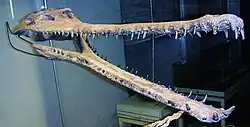 |
|
| Pacifichelys | P. urbinai | A sea turtle | 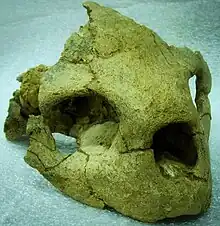 |
|
| Chelonia | Cheloniidae indet. | |||
| Eusuchia | E. sp. | |||
Invertebrates
| Invertebrates | |
|---|---|
| Fossils | Notes |
| Acanthina obesa, A. triangularis, Concholepas kieneri, Anadara sp., Dosinia sp., Herminespina sp. | |
Correlations
Laventan
| Formation | Honda | Honda | Aisol | Cura-Mallín | Pisco | Ipururo | Pebas | Capadare | Urumaco | Inés | Paraná | Map |
|---|---|---|---|---|---|---|---|---|---|---|---|---|
| Basin | VSM | Honda | San Rafael | Caldera | Pisco | Ucayali | Amazon | Falcón | Venezuela | Paraná | 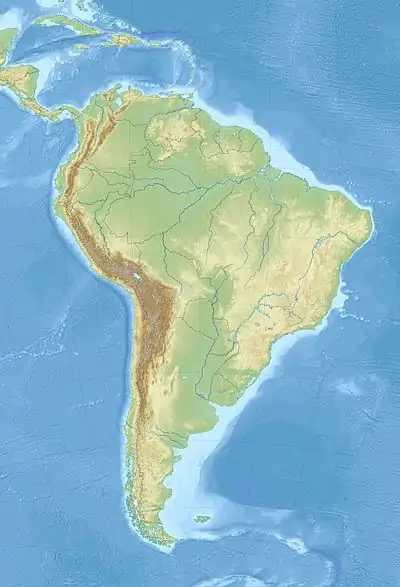 Pisco Formation (South America) | |
| Country | ||||||||||||
| Boreostemma | ||||||||||||
| Hapalops | ||||||||||||
| Miocochilius | ||||||||||||
| Theosodon | ||||||||||||
| Xenastrapotherium | ||||||||||||
| Mylodontidae | ||||||||||||
| Sparassodonta | ||||||||||||
| Primates | ||||||||||||
| Rodents | ||||||||||||
| Birds | ||||||||||||
| Terror birds | ||||||||||||
| Reptiles | ||||||||||||
| megalodon | ||||||||||||
| Flora | ||||||||||||
| Insects | ||||||||||||
| Environments | Fluvial | Fluvio-deltaic | Fluvio-lacustrine | Fluvio-deltaic | Fluvial | |||||||
| Volcanic | Yes | |||||||||||
See also
- Castilletes Formation, contemporaneous fossiliferous formation of the Cocinetas Basin, Colombia
- Cerro Ballena, contemporaneous fossil site of the Bahía Inglesa Formation of Chile
- Coquimbo Formation, contemporaneous fossiliferous formation of Chile
- Collón Curá Formation, contemporaneous fossiliferous formation of Patagonia, Argentina
- Honda Group, contemporaneous fossiliferous formation of Colombia
- Navidad Formation, contemporaneous fossiliferous formation of Chile
- Pebas Formation, contemporaneous fossiliferous formation of the Amazon Basin
- Urumaco, contemporaneous fossil site of the Falcón Basin, Venezuela
References
- ↑ Brand et al., 2004
- ↑ Brand et al., 2011
- 1 2 Lambert et al., 2010
- 1 2 De Muizon et al., 2003
- 1 2 De Muizon & Domning, 2002
- ↑ Báez Gómez, 2006, p.65
- ↑ Stucchi, 2007, p.368
- ↑ Altamirano Sierra, 2013, p.3
- 1 2 3 4 5 6 7 8 9 10 11 Báez Gómez, 2006, p.66
- ↑ Poma Porras et al., 2009, p.86
- ↑ De Muizon et al., 2004, p.287
- 1 2 Parham & Pyenson, 2010, p.231
- ↑ Bianucci et al., 2015, p.543
- 1 2 3 4 Stucchi, 2007, p.370
- 1 2 3 4 5 6 7 8 9 10 11 12 13 14 15 16 Sud Sacaco West at Fossilworks.org
- 1 2 3 4 5 6 7 8 9 10 Aguada de Loma at Fossilworks.org
- ↑ Amson & De Muizon, 2014, p.524
- 1 2 3 4 Hueso Blanco at Fossilworks.org
- 1 2 3 4 5 6 Sud Sacaco at Fossilworks.org
- ↑ Lambert et al., 2008
- 1 2 3 Cerro la Bruja at Fossilworks.org
- ↑ De Muizon, 1988, p.131
- ↑ De Muizon, 1988, p.88
- ↑ Demeré et al., 2005, p.115
- ↑ De Muizon, 1988, p.192
- ↑ De Muizon, 1988, p.82
- ↑ De Muizon, 1988, p.108
- ↑ Lambert et al., 2017
- ↑ Marx & Kohno, 2016, p.5
- ↑ Benites‐Palomino, Aldo; Vélez‐Juarbe, Jorge; Collareta, Alberto; Ochoa, Diana; Altamirano, Ali; Carré, Matthieu; Laime, Manuel J.; Urbina, Mario; Salas‐Gismondi, Rodolfo (August 2021). Lautenschlager, Stephan (ed.). "Nasal compartmentalization in Kogiidae (Cetacea, Physeteroidea): insights from a new late Miocene dwarf sperm whale from the Pisco Formation". Papers in Palaeontology. 7 (3): 1507–1524. doi:10.1002/spp2.1351. ISSN 2056-2799. S2CID 234058681.
- ↑ Collareta et al., 2017, p.261
- ↑ De Muizon, 1988, p.27
- ↑ Miocaperea pulchra at Fossilworks.org
- 1 2 3 4 Sacaco at Fossilworks.org
- ↑ De Muizon, 1988, p.66
- ↑ Göhlich, 2007, p.287
- ↑ Stucchi, 2007, p.369
- ↑ Stucchi et al., 2016, p.423
- ↑ Stucchi et al., 2016, p.419
- ↑ Chávez et al., 2007
- ↑ Altamirano Sierra, 2013, p.6
- ↑ Yauca at Fossilworks.org
- ↑ Salas-Gismondi, R.; Ochoa, D.; Jouve, S.; Romero, P.E.; Cardich, J.; Perez, A.; DeVries, T.; Baby, P.; Urbina, M.; Carré, M. (2022-05-11). "Miocene fossils from the southeastern Pacific shed light on the last radiation of marine crocodylians". Proceedings of the Royal Society B. 289 (1974). doi:10.1098/rspb.2022.0380. PMC 9091840. PMID 35538785.
- ↑ Cerro Colorado Pisco at Fossilworks.org
Bibliography
- Altamirano Sierra, Alí J. 2013. Primer registro de pelicano (Aves: Pelecanidae) para el Mioceno tardio de la formacion Pisco, Peru. Bulletin de l'Institut français d'études andines 42. 1–12. Accessed 2017-09-04.
- Amson, E., and C. De Muizon. 2013. A new durophagous phocid (Mammalia: Carnivora) from the late Neogene of Peru and considerations on monachine seals phylogeny. Journal of Systematic Palaeontology 12. 523–548. Accessed 2019-03-13.
- Báez Gómez, Diego A. 2006. Estudio paleoambiental de la Formación Pisco: Localidad Ocucaje. Revista del Instituto de Investigaciones FIGMMG 9. 64–69. Accessed 2017-09-04.
- Bianucci, G.; C. Di Celma; W. Landini; K. Post; C. Tinelli, and C. de Muizon. 2015. Distribution of fossil marine vertebrates in Cerro Colorado, the type locality of the giant raptorial sperm whale Livyatan melvillei (Miocene, Pisco Formation, Peru). Journal of Maps 12. 543. Accessed 2018-09-07.
- Brand, Leonard; Mario Urbina; Arthur Chadwick; Thomas J. DeVries, and Raul Esperante. 2011. A high resolution stratigraphic framework for the remarkable fossil cetacean assemblage of the Miocene/Pliocene Pisco Formation, Peru. Journal of South American Earth Sciences 31(4). 414–425. Accessed 2017-10-01.
- Brand, Leonard R.; Raúl Esperante; Arthur V. Chadwick; Orlando Poma Porras, and Merling Alomía. 2004. Fossil whale preservation implies high diatom accumulation rate in the Miocene–Pliocene Pisco Formation of Peru. Geology 32. 165–168. Accessed 2018-09-07.
- Chávez Hoffmeister, Martín Felipe; Marcelo Stucchi, and Mario Urbina Schmitt. 2007. El registro de Pelagornithidae (Aves: Pelecaniformes) y la avifauna neógena del Pacífico sudeste. Bulletin de l'Institut Français d'Études Andines 33. 175–197. Accessed 2019-03-13.
- Collareta, Alberto; Olivier Lambert; Christian de Muizon; Mario Urbina, and Giovanni Bianucci. 2017. Koristocetus pescei gen. et sp. nov., a diminutive sperm whale (Cetacea: Odontoceti: Kogiidae) from the late Miocene of Peru. Fossil Record 20. 259–278. Accessed 2018-09-07.
- Demeré, Thomas A.; Annalisa Berta, and Michael R. McGowen. 2005. The Taxonomic and Evolutionary History of Fossil and Modern Balaenopteroid Mysticetes. Journal of Mammalian Evolution 12. 99–143. Accessed 2019-03-13.
- Göhlich, Ursula B.. 2007. The oldest fossil record of the extant penguin genus Spheniscus — a new species from the Miocene of Peru. Acta Palaeontologica Polonica 52. 285–298. Accessed 2019-03-13.
- Lambert, Olivier; Giovanni Bianucci; Mario Urbina, and Jonathan H. Geisler. 2017. A new inioid (Cetacea, Odontoceti, Delphinida) from the Miocene of Peru and the origin of modern dolphin and porpoise families. Zoological Journal of the Linnean Society 179(4). 919–946. .
- Lambert, Olivier; Giovanni Bianucci; Klaas Post; Christian De Muizon; Rodolfo Salas Gismondi; Mario Urbina, and Jelle Reumer. 2010. The giant bite of a new raptorial sperm whale from the Miocene epoch of Peru. Nature 466(7302). 105–108. Accessed 2017-09-04.
- Lambert, Olivier; Giovanni Bianucci, and Christian De Muizon. 2008. A New Stem-Sperm Whale (Cetacea, Odontoceti, Physeteroidea) from the Latest Miocene of Peru. Comptes Rendus Palevol 7. 361–369. Accessed 2019-03-13.
- Marx, Felix G., and Naoki Kohno. 2016. A new Miocene baleen whale from the Peruvian desert. Royal Society Open Science 3. 1–27. Accessed 2019-03-13.
- De Muizon, Christian; H. Gregory McDonald; Rodolfo Salas Gismondi, and Mario Urbina Schmitt. 2004. The youngest species of the aquatic sloth Thalassocnus and a reassessment of the relationships of the nothrothere sloths (Mammalia: Xenarthra). Journal of Vertebrate Paleontology 24. 287–297. Accessed 2018-09-05.
- De Muizon, Christian; H. Gregory McDonald; Rodolfo Salas Gismondi, and Mario Urbina. 2003. A new early species of the aquatic sloth Thalassocnus (Mammalia, Xenarthra) from the Late Miocene of Peru. Journal of Vertebrate Paleontology 23(4). 886–894. Accessed 2017-09-04.
- De Muizon, Christian, and Daryl P. Domning. 2002. The anatomy of Odobenocetops (Delphinoidea, Mammalia), the walrus-like dolphin from the Pliocene of Peru and its palaeobiological implications. Zoological Journal of the Linnean Society 134(4). 423–452. Accessed 2017-09-04.
- De Muizon, C. 1988. Les Vertébrés fossiles de la Formation Pisco (Pérou). Troisième partie: Les Odontocètes (Cetacea, Mammalia) du Miocène. Editions Recherche sur les Civilisations 78. 1–244. Accessed 2019-03-13.
- Parham, J.F., and N.D. Pyenson. 2010. New sea turtle from the Miocene of Peru and iterative evolution of feeding ecomorphologies since the Cretaceous. Journal of Paleontology 84. 231–247. Accessed 2018-09-07.
- Poma Porras, Orlando; Edgard Horna Santillán, and Raúl Esperante. 2009. Baleen Fósil (Cetacea: mysticeti) en Sedimentos de la Cuenca Marina del Neógeno en la Formación Pisco, al Sur del Perú. Revista de Investigación Universitaria 1. 84–97. Accessed 2017-09-04.
- Stucchi, M.; R.M. Varas Malca, and M. Urbina Schmitt. 2016. New Miocene sulid birds from Peru and considerations on their Neogene fossil record in the Eastern Pacific Ocean. Acta Palaeontologica Polonica 61. 417–427. Accessed 2018-09-07.
- Stucchi, M. 2007. Los pingüinos de la Formación Pisco (Neógeno), Perú. 4th European Meeting on the Palaeontology and Stratigraphy of Latin America, Cuadernos del Museo Geominero 8. 367–373. Accessed 2017-09-04.
Further reading
- A. Alván, J. Apolín, and C. Chacaltana. 2004. Los dientes de Seláceos (Condrichthyies) y su aplicación estratigráfica en Las Lomas de Ullujaya (Ica, Perú). XIII Congreso Peruano de Geología. Resúmenes Extendidos 595-598
- A. Collareta, O. Lambert, W. Landini, C. Di Celma, E. Malinverno, R. Varas-Malca, M. Urbina and G. Bianucci. 2017. Did the giant extinct shark Carcharocles megalodon target small prey? Bite marks on marine mammal remains from the late Miocene of Peru. Palaeogeography, Palaeoclimatology, Palaeoecology 469:84-91
- R. Esperante, L. Brand, K. E. Nick, O. Poma, and M. Urbina. 2008. Exceptional occurrence of fossil baleen in shallow marine sediments of the Neogene Pisco Formation, Southern Peru. Palaeogeography, Palaeoclimatology, Palaeoecology 257:344-360
- A. Gioncada, A. Collareta, K. Gariboldi, O. Lambert, C. Di Clema, E. Bonaccorsi, M. Urbina and G. Bianucci. 2016. Inside baleen: Exceptional microstructure preservation in a late Miocene whale skeleton from Peru. Geology
- C. S. Gutstein, M. A. Cozzuol, A. O. Vargas, M. E. Suarez, C. L. Schultz and D. Rubilar-Rogers. 2009. Patterns of skull variation of Brachydelphis (Cetacea, Odontoceti) from the Neogene of the Southeastern Pacific. Journal of Mammalogy 90(2):504-519
- O. Lambert, A. Collareta, W. Landini, K. Post, B. Ramanssamy, C. Di Celma, M. Urbina and G. Bianucci. 2015. No deep diving: evidence of predation on epipelagic fish for a stem beaked whale from the Late Miocene of Peru. Proceedings of the Royal Society B 282:20151530
- J. Machare, T. DeVries, and E. Fourtanier. 1988. Oligo-Miocene transgression along the Pacific margin of South America: new paleontological and geological evidence from the Pisco basin (Peru). Géodyynamique 3(1-2):25-37
- R. Marocco and C. de Muizon. 1988. Los vertebrados del Neogeno de La Costa Sur del Perú: Ambiente sedimentario y condiciones de fosilización. Bulletin de l'Institut Français d'Études Andines 17(2):105-117
- C. de Muizon and D. P. Domning. 1985. The first records of fossil sirenians in the southeastern Pacific Ocean. Bulletin du Museum National d'Histoire Naturelle. Section C: Sciences de la Terre: Paléontologie, Géologie, Minéralogie, Paris: Muséum National d'Histoire Naturelle 7(3):189-213
- C. de Muizon. 1983. Pliopontos littoralis un nouveau Platanistidae Cetacea du Pliocene de la cote peruvienne. Comptes Rendus de l'Académie des Sciences Paris Série II (296)1101-1104
- C. de Muizon. 1978. Arctocephalus (Hydrarctos) lomasiensis, subgen. nov. et nov sp., un nouvel Otariidae du Mio-Pliocene de Sacaco. Bulletin de l'Institute Français d'Études Andines 7(3-4):169-189
- M. Urbina and M. Stucchi. 2005. Los cormoranes (Aves: Phalacrocoracidae) del Mio-Plioceno de la Formacion Pisco, Peru. Boletin de la Sociedad Geologica del Peru 99:41-49
- R. M. Varas Malca and A. Valenzuela Toro. 2011. A basal monachine seal from the middle Miocene of the Pisco Formation, Peru. Ameghiniana 48(4):R216-R217
- T. J. DeVries. 2008. Pliocene and Pleistocene Fissurella Bruguiére, 1789 (Gastropoda: Fissurellidae) from Southern Peru. The Veliger 50(2):129-148
- T. J. DeVries. 2007. Cenozoic Turritellidae (Gastropoda) from southern Peru. Journal of Paleontology 81(2):331-351
- T. J. DeVries, L. T. Groves, and M. Urbina. 2006. A new early Miocene Muracypraea Woodring, 1957 (Gastropoda: Cypraeidae) from the Pisco Basin of southern Peru. The Nautilus 120(3):101-105
- T. J. DeVries. 2003. Acanthina Fischer von Waldheim, 1807 (Gastropoda: Muricidae), an ocenebrine genus endemic to South America. The Veliger 46(4):332-350
- T. J. DeVries. 1997. Neogene Ficus (Mesogastropoda: Ficidae) from the Pisco Basin (Peru). Boletín de la Sociedad Geológica de Perú 86:11-18